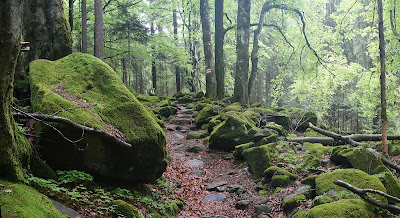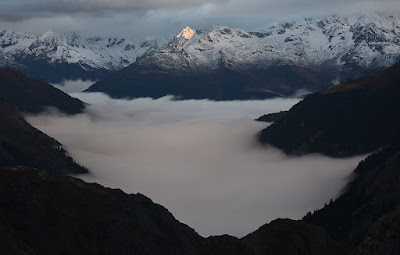Switzerland’s Sonntagszeitung
yesterday interviewed Zurich-based glacier researcher Matthias Huss on why another massive melting of the alpine glaciers is imminent. What follows is a summarised translation.The Swiss glacier monitoring network GLAMOS, which Huss heads up, has inspected 15 glaciers throughout Switzerland in recent weeks. They regularly survey the major glaciers in April, because the maximum snow depth is reached around this time after the winter snowfalls.
During last year’s measurements, Huss noticed that again there was alarmingly little snow – a factor that accelerated the historic glacier melt in the disastrous summer of 2022. At that time, more than 300 million tonnes of snow and ice meltwater flowed from Swiss glaciers in a single week in June. That's enough to fill an Olympic swimming pool every five seconds.
"What is happening now is something I have never seen before," Huss told
SonntagsZeitung in September 2022. One might think that nature would ease off after such a drastic and record decline. But the new measurements that Huss and his team have taken show the contrary.
Unfortunately, practically all the glaciers are in as bad a condition this year as they were in April 2022, and in some cases even worse. Only in the very west of the country are things looking better. Across Switzerland, the measurements are once again far below average. The condition of the Swiss glaciers is now critical for the second year in a row at the start of the melting period.
So the risk of another record glacier melting is increasing. In 2022, there was as little snow in April as there is now, and that was one of the main reasons for the record melt. But there was also a very warm May, and then a hot summer. It would be less bad for the glaciers if it stays cooler this year, as in 2019 when the melting started late.
Climatologists expect even higher global temperatures this year than in 2022. The risk is very high that we will have another massive loss of glacier ice. If there is no snow in winter, there is no "food" for the glaciers, and the ice has no protective layer when the temperatures rise. This time last year, there was practically no snow on the Findel glacier above Zermatt.
 |
The Findel Glacier above Zermatt in 2009
Photo by courtesy of Alpine Light & Structure |
It's more or less the same again this year. Again, there is only a thin layer of snow on the Findel glacier, even though these measurements were taken up on the Cima di Jazzi, at 3,800 metres. This also poses a risk for the team taking the measurements, as normally there are several metres of snow up there in April. This covers the crevasses, and the GLAMOS team previously never had to rope up. But last year and this year, the crevasses were hidden under only a thin layer of snow, and there was a danger of breaking through.
 |
Remnants of a glacier collapse, Morteratsch Glacier, 2011
Photo by courtesy of Alpine Light & Structure |
This year, Huss was also on the Strahlhorn, at over 4, 000 metres – this was the first time that the monitoring programme had made snow measurements at over 4,000 metres. To their astonishment, there was no snow even at these altitudes. The bare ice showed through. It is possible that in May, when it slowly gets warmer, some more snow will accumulate. But we don't know that yet.
This may also be an effect of last year's record melt. In autumn, there was only a glassy, icy surface left on the Strahlhorn instead of a layer of old snow. On this surface, the snow didn't stand a chance in the winds up there. It was simply blown away, and this was seen very impressively.
As this was the first measurement to be made above 4,000 metres, Huss can’t say how often this has happened. But it is clear that at these altitudes the glacier has to feed on snow. Ice is always lost in the lower part, even in cooler years, and this must be compensated for in the upper part. If a glacier receives too little or no snow in winter, then it can't accumulate. So if it's losing mass at 4,000 metres, no glacier can withstand that in the long term. No snow, no glaciers, it's very simple.
It has been raining at lower altitudes for the past week, and there was an appreciable catch-up in snowfall during April. However, the measurements made by GLAMOS show that this was not enough to make up for the overall deficit of the dry winter.
 |
The Jungfraujoch in 2017
Photo by courtesy of Alpine Light & Structure |
On the Jungfraujoch (3,463 metres), for example, snow measurements have been taken every year since 1921 using exactly the same method. Up till now, the snow that falls there in winter has always melted only partially in summer, allowing the glacier to accumulate. But last summer, for the first time ever, more snow melted than had fallen the winter before. So for the first time there was a loss on the Jungfraujoch. That was also because there was so little snow in 2022. This winter, however, GLAMOS found even less snow in the same places at the end of March.
In the west of Switzerland this winter, there were some weather conditions in December and January that brought a lot of snow. That's why, for example, the Tsanfleuron glacier near Les Diablerets is even a little above average. But conditions are particularly bad in the southern Valais, in Ticino and in the Engadine. On the Pers glacier right next to Morteratsch, there should be over two metres of snow on the tongue at this time. GLAMOS often found less than one metre.
Of the 20 glaciers that GLAMOS measures precisely, the team had to stop measuring three last year. In 2023, the team will probably also have to give up the measurements on the St Annafirn glacier above Andermatt. Not because the glacier is completely gone, but because it has simply collapsed so much. It is dissolving and is now only covered by debris. It is no longer worthwhile to continue measuring. It would also be too dangerous because of the falling rocks from the unstable rock faces. Last year, boulders were falling continuously.
Switzerland’s small glaciers will be lost, even if global warming is limited to 1.5 degrees, and that is already a huge challenge for the international community. “We have to try to stabilise the climate in such a way that we can at least still save the large glaciers. If we don't manage that, we will lose our snowy mountains. In summer we will have only grey rubble,” Huss says.
Huss is campaigning for the adoption of the
Climate Change Act, on which Swiss citizens vote on 18 June. Opponents say that the law is too expensive, that a different path should be taken. Huss comments that “We definitely don't have time to debate for decades. We have been talking about climate change for at least 30 years now. The climate models have been confirmed and we are already suffering from extreme events worldwide. We have to act now.”
“When you stand on a glacier like this, when you go to the same place again and again and see how quickly the landscape is changing, it becomes very clear. And for us in Switzerland, climate protection is also landscape conservation. If we want to preserve our beautiful Alpine panorama, if we still want to ski in winter instead of sliding down white synthetic snowchutes, then we have to stop climate change. As a wealthy country, Switzerland can and must make its contribution here. And we can afford to pay for it. In the long run, this will pay off in any case.”
Reference


















